
Hessilhead
Encyclopedia

Beith
Beith is a small town situated in the Garnock Valley in North Ayrshire, Scotland approximately 20-miles south-west of Glasgow. The town is situated on the crest of a hill and was known originally as the "Hill o' Beith" after its Court Hill.-History:-Name:Beith's name is thought to emanate from...
, North Ayrshire
North Ayrshire
North Ayrshire is one of 32 council areas in Scotland with a population of roughly 136,000 people. It is located in the south-west region of Scotland, and borders the areas of Inverclyde to the north, Renfrewshire to the north-east and East Ayrshire and South Ayrshire to the East and South...
, Scotland
Scotland
Scotland is a country that is part of the United Kingdom. Occupying the northern third of the island of Great Britain, it shares a border with England to the south and is bounded by the North Sea to the east, the Atlantic Ocean to the north and west, and the North Channel and Irish Sea to the...
. Hessilhead used to be called Hazlehead or Hasslehead. The lands were part of the Lordship of Giffen
Barony and Castle of Giffen
The Barony of Giffen and its associated 15th-century castle were in the parish of Beith in the former District of Cunninghame, now North Ayrshire. The site may be spelled Giffen or Giffin and lay within the Lordship of Giffin, which included the Baronies of Giffen, Trearne, Hessilhead, Broadstone,...
, and the Barony of Hessilhead, within the Baillerie of Cunninghame and the Parish of Beith. The castle was situated at .
Hessilhead Castle


Timothy Pont
Timothy Pont was a Scottish topographer, the first to produce a detailed map of Scotland. Pont's maps are among the earliest surviving to show a European country in minute detail, from an actual survey.-Life:...
in around 1604 records that the castle was protected by substantial ditches and stood on a loch. This loch has long since been drained and the ditches filled in.

Hessilhead in its later days was occupied by the family of Lord Glasgow
Earl of Glasgow
Earl of Glasgow is a title in the Peerage of Scotland. It was created in 1703 for David Boyle, Lord Boyle, one of the commissioners who negotiated the Treaty of Union uniting the Kingdom of England and the Kingdom of Scotland into the United Kingdom of Great Britain...
, and after they left, the proprietor, a Mr. Macmichael, about the year 1776, took off the roof and allowed the place to go to ruin. Circa 1887 - 92 it is described as being enclosed as a garden. Dobie records the despoiler of Hessilhead as a Mr. Carmichael, who sold the materials from the castle and also removed parts of the walls, as well as cutting down and selling an impressive old Yew tree. In the 1960s the remains of the castle were blown up on the instructions of Howie of Dunlop.
Dobie also records that a little to the south of the ruined castle there was a singular echo, which slowly and plaintively repeated the voice once, throwing a melancholy charm over this scene of departed grandeur.
The history of the lands of Hessilhead
The first recorded holder of the lands of Hessilhead was Hugh de Eglintoun, who obtained the lands following forfeiture. Eglin, Lord of Eglintoun is the first of the family recorded, living during the reign of King Malcolm Canmore; he may have been one of the SaxonAnglo-Saxons
Anglo-Saxon is a term used by historians to designate the Germanic tribes who invaded and settled the south and east of Great Britain beginning in the early 5th century AD, and the period from their creation of the English nation to the Norman conquest. The Anglo-Saxon Era denotes the period of...
barons who accompanied King Malcolm (who died in 1093) on his successful return to Scotland. The family continued until Elizabeth de Eglintoun, the sole heir, married Sir John de Montgomerie of Eaglesham
Eaglesham
Eaglesham , is a village and parish set in the west central Lowlands of Scotland - population 3,127 . Today it is chiefly a dormitory town for commuters to nearby Glasgow. The village is distinctive in being based around a large triangular green...
. Elizabeth's mother was Giles, daughter of Walter, lord high steward of Scotland, and sister of King Robert II
Robert II of Scotland
Robert II became King of Scots in 1371 as the first monarch of the House of Stewart. He was the son of Walter Stewart, hereditary High Steward of Scotland and of Marjorie Bruce, daughter of Robert I and of his first wife Isabella of Mar...
.
When Hugh Eglintoun of that Ilk, her father, died soon after 1378 the Montgomerie family inherited the lands and hereafter Hessilhead's history is bound up with that family.
Sir John Montgomerie of Hessilhead and Corsecraigs inherited the estate from his father, Hugh Montgomerie of Bawgraw (Balgray). John was slain at the battle of Flodden in 1513 and the estate passed to his son Hugh, who died on 23 January 1556. Hugh's heir was his son John who was appointed one of the tutors to Hugh, third Earl of Eglintoun. John married Margaret Fraser of Knock and was succeed in 1558 by his son Hugh. This young Hugh was a member of the Convention Parliament of 1560, at which the Protestant Confession of Faith was established.
In around 1576, Gabriel Montgomerie of nearby Scotston was slain by adherents of the Montgomeries of Hessilhead. Hugh had a son Robert who inherited in 1602, passing the estate on to his son Robert circa 1623. This Robert was a Commissioner of Supply for Ayrshire and his son, also Robert, succeeded in 1648 and was one of the representatives for Ayrshire in the first parliament of King Charles II. He had a daughter, Mary, who married MacAulay of Ardincaple.
Robert Montgomerie sold Hessilhead to the seventh Earl of Eglinton's (1613–1669) second son, The Right Hon. Francis Montgomerie inherited the nearby Giffen Castle
Barony and Castle of Giffen
The Barony of Giffen and its associated 15th-century castle were in the parish of Beith in the former District of Cunninghame, now North Ayrshire. The site may be spelled Giffen or Giffin and lay within the Lordship of Giffin, which included the Baronies of Giffen, Trearne, Hessilhead, Broadstone,...
and lived an eventful life. He was one of the Lords of the Privy Council, and a Commissioner of the Treasury, in the reign of William III and Queen Anne. He was appointed in 1706 as one of the Commissioners for Scotland for the Treaty of Union.
The Act of Union was very unpopular in some quarters.
A song of 1706 on the Union reads:-
"There's Roseberry, Glasgow, and Dupplin, And Lord Archibald Campbell and Ross, The President, Francis Montgomery, Wha ambles liked any paced horse." |
In another, called "Lines upon the Rogues in Parliament," is the following stanza :-
"Thou Francis of Giffen thou's bigot as hell, And Brodie in nonsense in this doth excell, For rebellion engrained you may each bear the bell, Wherefore sin on and be damned." |
Francis built an addition to the old tower as well as slating the roof, making it one of the finest properties in the district. Francis also planted extensively, mostly as avenues or rides running to the mansion house. This Dutch style had the avenues in straight lines and at right angles. In the 1860s much of this designed landscape still existed.
In 1697 Francis was made one of the commissioners looking into witchcraft
Witchcraft
Witchcraft, in historical, anthropological, religious, and mythological contexts, is the alleged use of supernatural or magical powers. A witch is a practitioner of witchcraft...
following the Christian Shaw
Lambroughton
Lambroughton is a village in the old Barony of Kilmaurs, North Ayrshire, Scotland. This is a rural area famous for its milk and cheese production and the Ayrshire or Dunlop breed of cattle.-Origins of the name:...
case in which five out of 24 accused persons were burned at the stake. In 1692 the spelling of the name was Hyslehead.
Francis's son John contracted such debts that Hessilhead had to be disposed of by judicial sale in 1722 and was bought by Colonel Patrick Ogilvie who had married Elizabeth, one of John's sisters. The colonel sold the property to Robert Brodie of Calderhaugh, who in turn in 1768 sold it to Michael Carmichael.
The coat of arms
Coat of arms
A coat of arms is a unique heraldic design on a shield or escutcheon or on a surcoat or tabard used to cover and protect armour and to identify the wearer. Thus the term is often stated as "coat-armour", because it was anciently displayed on the front of a coat of cloth...
of the Montgomeries of Hessilhead are Azure
Azure
In heraldry, azure is the tincture with the colour blue, and belongs to the class of tinctures called "colours". In engraving, it is sometimes depicted as a region of horizontal lines or else marked with either az. or b. as an abbreviation....
, two lances of Tournament, proper, between three Fleurs-de-lis, Or
Or (heraldry)
In heraldry, Or is the tincture of gold and, together with argent , belongs to the class of light tinctures called "metals". In engravings and line drawings, it may be represented using a field of evenly spaced dots...
, and in the chief point an Annulet
Annulet
Annulet can refer to:* Annulet , a mark in distinction* Annulet , a fillet or ring encircling a column* The Annulet, Charissa obscurata, a species of moth in the family Geometridae...
, Or, Stoned, Azure, with an Indentation
Indentation
An indentation may refer to:* A notch, or deep recesses; for instance in a coastline, or a carving in rock* The placement of text farther to the right to separate it from surrounding text....
in the side of the shield, on the Dexter
Dexter and sinister
Dexter and sinister are terms used in heraldry to refer to specific locations in an escutcheon bearing a coat of arms and by extension also to a crest. "Dexter" means to the right from the viewpoint of the bearer of the arms, to the left of that of the viewer...
side.
The Auld Kirk of Beith
Beith
Beith is a small town situated in the Garnock Valley in North Ayrshire, Scotland approximately 20-miles south-west of Glasgow. The town is situated on the crest of a hill and was known originally as the "Hill o' Beith" after its Court Hill.-History:-Name:Beith's name is thought to emanate from...
had the Hessilhead loft in the East Wing. The loft and the carved wood Montgomerie of Hessilhead coat of arms were removed when the new church was built.
The OS map shows that Hessilhead Cottage sat next to a well maintained walled garden, however by 1897 the garden had fallen into ruin. A gamekeepers cottage with a nearby pheasantry is marked from 1912, when a curling
Curling
Curling is a sport in which players slide stones across a sheet of ice towards a target area. It is related to bowls, boule and shuffleboard. Two teams, each of four players, take turns sliding heavy, polished granite stones, also called "rocks", across the ice curling sheet towards the house, a...
pond makes its first appearance, to the north-west of the castle ruins. In 1827 a lime works is shown on the map in the grounds of the castle.
Trearne
In 1807, Dr. Robert Patrick of Trearne purchased the Hessilhead estate. Robert Patrick was an army medic and was appointed Inspector of Hospitals in 1801. John Shedden Patrick F.R.S.E. was his heir in 1838 and in 1844 Robert Shedden Patrick of Trearne and Hessilhead succeeded.James Dunlop
James Dunlop
James Dunlop was an astronomer's assistant who was hired by Sir Thomas Brisbane to work at his private observatory, once located at Paramatta , New South Wales, about twenty-three kilometres west of Sydney, Australia during the 1820s and 1830s...
lived at Trearne Lodge in 1820 with his wife. James met Major General Sir Thomas Brisbane through the Patricks of Trearne and went on to become the Astronomer Royal for New South Wales, Sir Thomas being the Governor of New South Wales and a great enthusiast for astronomy. James Dunlop died in Australia, having become a Fellow of the Royal Society, London and Edinburgh and the recipient of many medals recognising his achievements.
Trearne House had been built about 1870, almost on the 'footprint' of an older mansion house. Mr and Mrs Ralston-Patrick lived for some time in Burnhouse Manor
Barony and Castle of Giffen
The Barony of Giffen and its associated 15th-century castle were in the parish of Beith in the former District of Cunninghame, now North Ayrshire. The site may be spelled Giffen or Giffin and lay within the Lordship of Giffin, which included the Baronies of Giffen, Trearne, Hessilhead, Broadstone,...
until their new house was ready for them. By 1877 Mr and Mrs Ralston-Patrick were living in the new Trearne. Jenny Kerr was probably the last person born at Trearne Lodge; her mother was living there with her parents when her father was a Lieutenant in the Glasgow Highlanders, and was fighting in France during the first World War. Over Hessilhead was on the Trearne Estate along with Hessilhead, Townend of Hessilhead and an estate saw mill with its water wheel driven by the Dusk Water. During WW2 Trearne House was used by the army, following which it became Gresham House Boarding School. The school had a cook, a matron and five or six teachers up. There would be about thirty boys in the private boarding school, many of whom had parents who worked abroad.
Limestone quarries
The remains of many small and large fossiliferous limestone quarries are present in the area and have led to the destruction of much of the old estate features. Trearne House and the ancient Saint Bridget's chapel and well suffered the same fate. The flooded quarry close to the old castle is now in use by the Hessilhead Wildlife Rescue Centre for the recuperation of swans and other waterfowl. Limekilns were present in the woods below Over Hessilhead Farm and near Broadstone HallSpeir's school
Spier's school, at Beith, in North Ayrshire, Scotland, NS 35355327, KA15 1LU, was opened in 1888 and closed in 1972. The school, now demolished, was built using Ballochmyle red sandstone and was reminiscent of the ancient Glasgow University. The school motto was 'Quod verum tutum'...
. A 'lime works' is shown on the 1827 map of the parish.
The Templelands of Cunninghame
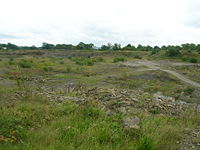
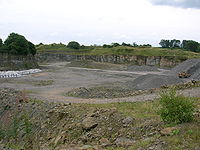
Knights Templar
The Poor Fellow-Soldiers of Christ and of the Temple of Solomon , commonly known as the Knights Templar, the Order of the Temple or simply as Templars, were among the most famous of the Western Christian military orders...
had owned considerable lands and properties in the bailiary of Cunninghame, regality of Kilwinning and in the early 17th century, Robert Montgomerie acquired the rights to these Templelands from the Sandilands family of Calder, the Lords Torphichen and thus became the feudal superior. He also had the lands of the bailiary of Kyle Stewart. The value of these lands largely lay in their near exemption from taxation. In about 1720 the lands passed to the Wallaces of Carnell, at Fiveways near Kilmarnock. Later Dr. Robert Patrick of Trearne & Hessilhead purchased the superiority, although this was of little real value after the abolition of heritable jurisdictions in 1747.
Coldstream mill
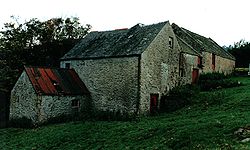
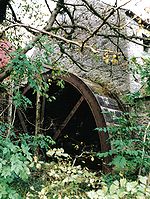
John Andrew is listed in 1782 as the heir to John Miller, his grandfather, miller in Coldstream. In 1810, the mill passed to William Fulton of Beith
Beith
Beith is a small town situated in the Garnock Valley in North Ayrshire, Scotland approximately 20-miles south-west of Glasgow. The town is situated on the crest of a hill and was known originally as the "Hill o' Beith" after its Court Hill.-History:-Name:Beith's name is thought to emanate from...
, by whom it was sold to David Kerr, merchant of Beith and Andrew Gibson, baker, in 1815. William Caldwell then purchased the mill and it remained with the family for the next hundred years. Thomas Caldwell was the miller in 1841, but by 1871 Thomas is farming and the miller is Robert Jack. David Fergie is the miller in 1881, Thomas having retired. By 1891 Robert Jack is the miller again and the sons of Thomas, William and Thomas, are the owners. In 1921 the Smith family bought the mill from Thomas Caldwell, Joseph Smith having been the miller since 1911. Andrew, son of Joseph, worked the mill until 1991.
After being enlarged, Coldstream Mill was used for preparing animal feed or meal, grinding linseed cake, beans, maize and barley. The mill had three sets of stones, two working whilst one was being dressed (serviced and sharpened). The mill never had an electricity supply and never needed any auxiliary power thanks to the mill pond. The mill was the last traditional working water mill in Ayrshire and one of the last in Scotland. Some of the items for the mill are on display at the nearby Dalgarven Mill
Dalgarven Mill
Dalgarven Mill is near Kilwinning, in the Garnock Valley, North Ayrshire, Scotland and it is home to the Museum of Ayrshire Country Life and Costume. The watermill has been completely restored over a number of years and is run by the independent Dalgarven Mill Trust.The village of Dalgarven was...
museum near Kilwinning. The mill was converted to a private house and the waterwheel and mill pond have been preserved as part of this development.
The Farm Town of Hessilhead
The 1858 OS mapOrdnance Survey
Ordnance Survey , an executive agency and non-ministerial government department of the Government of the United Kingdom, is the national mapping agency for Great Britain, producing maps of Great Britain , and one of the world's largest producers of maps.The name reflects its creation together with...
shows a small settlement with a school, a dwelling called Damback, a sawmill and a mill dam nearby. The school had closed by 1897 and Howie's of Dunlop, the owners of the estate, removed the bell in the 1930s. A small Hessilhead 'Farm Town' hamlet still exists (co-ordinates 55°44′34.2"N 04°34′31.9"W), dating from at least the 1740s judging by William Roy's map as previously noted. The site appears to be a rare survival of a typical 18th century Farm Town. Porterfield relates that the name of this clachan
Clachan
A clachan is a type of small traditional settlement common in Ireland and Scotland until the middle of the 20th century. It is usually defined as a small village lacking a church, post office, or other formal building. Their origin is unknown, but it is likely that they are of a very ancient...
was 'Haselet' from 'Hasslehead Hamlet', previously 'Nethertown'. Matthew Pollock who established Beith's Caledonia Cabinet Works was educated here and after the school's closure he obtained the bell for use at his works to signal the start and end of the day; it is now located at Netherhouses, near old Templehouse, Dunlop. The school had originally been single storeyd and thatched, however a second storey was added in 1844 and it was slated.
The origin of Farm Towns lies in the common medieval sub-division of land called a ploughgate (104 acres), the extent of land which one plough team of oxen could till in a year. This area was again subdivided into four husbandlands, each of 26 acres (105,218.4 m²). Each husbandland could provide two oxen and eight oxen were need for a plough-team. This arrangement led to small farm towns like Hessilhead being established with accommodation for at least four men in six to eight houses, taking practical considerations into account.
Duskwater Cottage was the blacksmith's and a cobbler also worked here.
Balgray
The Balgray lands were at one time a part of the Hessilhead estate, and were in the 16th century were owned by the Montgomeries. John Stevenson and John Muir were connected with these lands in the early 18th century. Only a cottage and barn survive from what was a larger group of farm buildings, recorded on OS maps, most of which survived until the mid 20th century. The 1797 (dated on the lintel) barn, category B listed, would have been thatched or slated originally, with a lime harl that has entirely disintegrated. An arched opening, now blocked up, suggests that originally this building was used as a cart shed. Ventilation slits survive on all sides.The small wing to the 1767 cottage could have been used as storage or for cattle; the surviving doocot shows that pigeons were kept in the loft above as an additional source of food. The category C(s) listed cottage, now much altered, had small windows typical of the 18th century and has some smart details that separate it from the typical rubble-built smallholding, with very prominent skewputts and cavetto eaves course illustrating its sophistication.
The Hessilhead and Thirdpart feud
A shocking series of incidents occurred in the locality of Hessilhead, starting on 19 July 1576 when the Lady of Hessilhead slapped one Robert Kent, servant to Gabriel, brother of John Montgomerie. The servant complained to his master and Gabriel went to his brother at the old Thirdpart mansion for advice. John advised him to seek revenge and the next morning Gabriel and Robert gained entry into Hessilhead castle where they found the lady alone, upon which they grabbed her by the hair, pulled her onto the floor, kicked her in the bowels, and bruised her shamefully. Gabriel intended to shoot the Laird, however the whole household was now awake and the two only just managed to escape by stealing a horse and locking the castle gate from the outside. The Laird, Hew Montgomerie, hastened to Thirdpart where John and Gabriel came out with pistols and drawn swords and attacked Hew Montgomerie, injuring him on various parts of his body and leaving him for dead. He was rescued by some neighbours who took him to Hessilhead castle where he recovered from his wounds.Soon afterwards, Hessilhead men, including one named Giffen, killed Gabriel Montgomerie after setting up an ambush for him. On the 26th August, John, Kent and another brother, Walter, went to try and kill the Laird, but could not find him. None of the court cases resulted in a guilty verdict, because honour had been satisfied on both sides.
The Spectral Knight of Hessilhead and the Bride of Aiket
Henry Montgomerie of Hessilhead was pledged to marry his true love, Anna Cunninghame of Aiket CastleBarony of Aiket
The Barony of Aiket with its castle, lay within the old feudal bailiary of Cunninghame. The barony lands equate to the extant Parish of Dunlop, East Ayrshire, Scotland.-Aiket castle:...
. They were to marry upon his return from the crusades
Crusades
The Crusades were a series of religious wars, blessed by the Pope and the Catholic Church with the main goal of restoring Christian access to the holy places in and near Jerusalem...
, however Allan Lockhart, son of a neighbouring Baron began to pay frequent visits to the inmates of Aiket Castle. His courtship was in vain and he would have no success unless the Crusades were to claim Henry Montgomerie. After many more months had passed Allan decided to used trickery and eventually persuaded a foot soldier recently returned from the Crusades to tell the false tale of the death of Henry Montgomerie. The ruse was carried off with success and after a short while Allan pressed his attentions again and the marriage day was set.
On the very day of the wedding, Henry returned to Hessilhead castle and discovered the treacherous act, but he fell from his horse on his way to claim his bride and died. At midnight the wedding feast was halted abruptly by the figure of the fully armour clad Neil Montgomerie striding into Aiket Castle hall, lifting up the Lady Anna and then vanishing into the night. Neither soldier nor bride were ever found. The Lockhart, Loccard or Lockhard family are believed to have been the first owners of the Barony of Kilmarnock. Symington is named after a Flemish
Flemish people
The Flemings or Flemish are the Dutch-speaking inhabitants of Belgium, where they are mostly found in the northern region of Flanders. They are one of two principal cultural-linguistic groups in Belgium, the other being the French-speaking Walloons...
knight, Simon Loccard.
Alexander Montgomerie
The 16th century poet, Alexander MontgomerieAlexander Montgomerie
Alexander Montgomerie , Scottish Jacobean courtier and poet, or makar, born in Ayrshire. He was one of the principal members of the Castalian Band, a circle of poets in the court of James VI in the 1580s which included the king himself. Montgomerie was for a time in favour as one of the king's...
was a younger son of the Renfrewshire laird Hugh Montgomerie of Hessilheid (d. 1558), and related both to the Earl of Eglinton
Earl of Eglinton
Earl of Eglinton is a title in the Peerage of Scotland.Some authorities spell the title: Earl of Eglintoun In 1859 the thirteenth Earl of Eglinton, Archibald Montgomerie, was also created Earl of Winton in the Peerage of the United Kingdom, which gave him an automatic seat in the House of Lords,...
and to King James VI (later James I of England
James I of England
James VI and I was King of Scots as James VI from 24 July 1567 and King of England and Ireland as James I from the union of the English and Scottish crowns on 24 March 1603...
). Nothing is known about his life before about 1580, but contemporary or near-contemporary accounts suggest that he was brought up as a Protestant, spent some time in Argyll before leaving for the Continent, and was converted to Catholicism in Spain. He may have served in the Scottish forces in The Netherlands for a time in the later 1570s. He died between the years 1607 and 1611.
The range of his work is extensive, from elegant court songs to the bitter, sometimes contorted word-play of the sonnets associated with the dispute over his pension, from witty pieces addressed to the king to the profound religious sensibility of ‘A godly prayer'. Montgomerie is one of the finest of Middle Scots poets, and perhaps the greatest Scottish exponent of the sonnet form. Robert Burns
Robert Burns
Robert Burns was a Scottish poet and a lyricist. He is widely regarded as the national poet of Scotland, and is celebrated worldwide...
was indebted to Alexander as is apparent from his imitating his style and adopting some of his quaint expressions.
The Cherrie and the Slae, which he probably revised and completed shortly before his death, is an ambitious religious allegory, employing a demanding, lyrical form which suggests that it was intended for singing, despite its considerable length. The Cherry and the Sloe in the title may derive from an illusion to the cherry being virtuous and the sloe being easily plucked but bitter to the taste and representing vice. His poetry reaches back to the earlier Makars, Robert Henryson, William Dunbar and Gavin Douglas, and some of his work invites comparison with Baroque writers. Alexander was one of the last court poets to write in Scots. A later poem was entitled a 'Spring Morning' and described one of the royal palaces, probably Linlithgow, on such a morning.
Alexander's son, also Alexander, was reportedly bewitched, together with his cousin, Mrs. Vallange. The case, and therefore the witch, went to trial, because of their 'trouble and sickness', but the court's verdict isn't recorded.
Archaeology

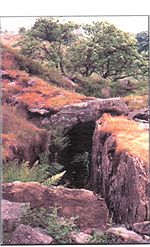
Rocking stone
Rocking stones are large stones that are so finely balanced that the application of just a small force causes them to rock. They are found throughout the world. Some are man-made megaliths, but others are natural, often left by glaciers.Logan or rocking stones are known in Scotland sometimes as...
(NS 3827 5542) is a large glacial erratic boulder of basaltic greenstone lying on porphyrite that some associate with the Druid
Druid
A druid was a member of the priestly class in Britain, Ireland, and Gaul, and possibly other parts of Celtic western Europe, during the Iron Age....
s, part of the old Hessilhead Barony. It no longer rocks due to people digging beneath to ascertain its fulcrum. It is in a small wood and surrounded by a circular drystone wall.
A cleft in the west-front of Cuff hill is still known as 'St. Inan's Chair' and said to have been used by the saint as a pulpit
Pulpit
Pulpit is a speakers' stand in a church. In many Christian churches, there are two speakers' stands at the front of the church. Typically, the one on the left is called the pulpit...
. and a crystal clear holy well existed nearby, now sadly covered over (2006). On Cuff Hill are also a group of four standing stones, the Druid's Grave and the likely site of a pre-reformation chapel at Kirklee Green.
A chapel and well dedicated to St. Bridget existed at nearby Trearne on a low hill, with an associated burial ground and a nook in which was set a carving of two figures, possibly a cat and a rabbit, measuring 25 inches (635 mm) by 15 inches (381 mm). The ruins at Trearne were destroyed by quarrying in comparatively recent times.
Railways
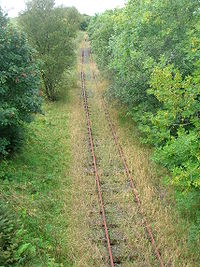
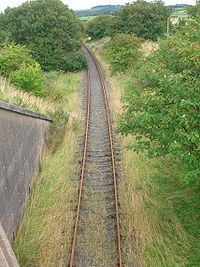
Glasgow, Barrhead and Kilmarnock Joint Railway
The Glasgow, Barrhead and Kilmarnock Joint Railway was a railway co-owned by Caledonian Railway and Glasgow and South Western Railway and was an amalgation of two different lines: the Glasgow, Barrhead and Neilston Direct Railway and the Glasgow and Kilmarnock Joint Railway.-Glasgow, Barrhead and...
. The station opened at opened on 26 June 1873 as Beith. It was renamed Beith Town on 28 February 1953, and closed permanently to passengers on 5 November 1962. Freight services continued at the station until 1964. The station was the terminus
Terminal Station
Terminal Station is a 1953 film by Italian director Vittorio De Sica. It tells the story of the love affair between an Italian man and an American woman. The film was entered into the 1953 Cannes Film Festival.-Production:...
of a five mile (8 km) branch from Lugton
Lugton railway station
Lugton railway station was a railway station serving the hamlet of Lugton, East Ayrshire, Scotland. The station was originally part of the Glasgow, Barrhead and Kilmarnock Joint Railway.-History:...
.
Today, the line to Beith is still in existence (2008) until just before the site of Barrmill railway station
Barrmill railway station
Barrmill railway station was a railway station serving the village of Barrmill, North Ayrshire, Scotland. The station was originally part of the Glasgow, Barrhead and Kilmarnock Joint Railway.- History :...
, where it then heads south along the original route of the Lanarkshire and Ayrshire Railway
Lanarkshire and Ayrshire Railway
The Lanarkshire and Ayrshire Railway was a railway company in Scotland built in the late 19th century that provided services between Ardrossan and Glasgow, with branches to Irvine and Kilbirnie. The line was operated by the Caledonian Railway with an aim to compete with the Glasgow and South...
until it reaches DM Beith. DM Beith reportly no longer require the rail connection.
A live railway emergency exercise at Lugton on the DM Beith branchline in 2000 played a vital part in the ongoing process of protecting Scotland’s rail passengers. The exercise simulated a collision between two passenger trains carrying 270 passengers. The aim was to test the emergency services’ response and management co-ordination by replicating real accident conditions as closely as possible. Strathclyde police co-ordinated the exercise in conjunction with the rail industry in Scotland, the British Transport Police, Civil Police, Scottish Ambulance Service, Fire Brigade, local authorities and Government emergency planning co-ordinators.
Hessilhead Wildlife Rescue Centre
Hessilhead has a wildlife rescue center run by Andy and Gay Christie for over 20 years. They rescue and rehabilitate injured and abandoned animals and birds. They treat over 3000 creatures a year. They recently built a swan treatment room. They have x-ray facilities and a surgery suite, as well as the part-time services of a veterinarianVeterinarian
A veterinary physician, colloquially called a vet, shortened from veterinarian or veterinary surgeon , is a professional who treats disease, disorder and injury in animals....
.
See also
- Eglinton Country ParkEglinton Country ParkEglinton Country Park is located in the grounds of the old Eglinton Castle estate, Kilwinning, North Ayrshire, Scotland . Eglinton Park is situated in the parish of Kilwinning, part of the former district of Cunninghame, and covers an area of 400 hectares...
The Eglintouns of Hessilhead. - Silverwood, AyrshireSilverwood, AyrshireSilverwood in the Parish of Kilmarnock lies in East Ayrshire, Scotland. This was once a small estate with a mansion house; it is now a farm. The plantation nearby is named after it.-The estate:...
Robert Montgomerie of Silverwood and Hessilhead - Barony of LadylandBarony of LadylandThe Barony of Ladyland was in the old feudal Baillerie of Cunninghame, near Kilbirnie in what is now North Ayrshire, Scotland.- The history of the Barony of Ladyland :...
- Blae Loch, BeithBlae Loch, Beith- Natural history :The site is a designated 'Local Wildlife Site' following a survey in 1981 by the Scottish Wildlife Trust and others. The survey recorded that the site is a 'Phragmites dominated area with open water'. The surveyors record that "The loch is surrounded to a great extent by bed of...
- part of the old estate.

